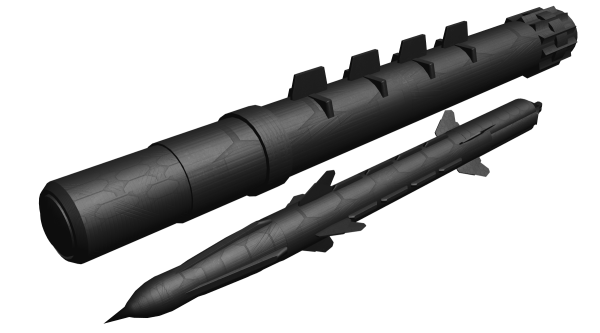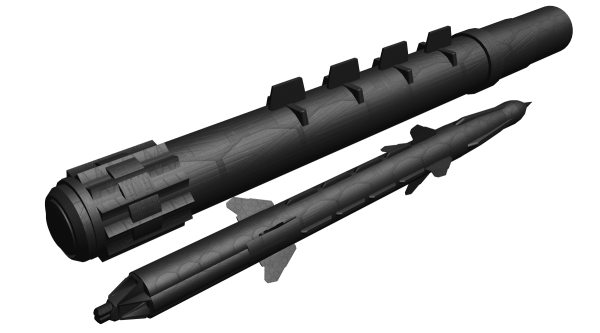Table of Contents
| General Information | |
|---|---|
| Primary Users | Colonial Pact Trade Alliance |
| Start Date of Production | 981 N.C.C. |
| Per Unit Cost | 9,500 CC |
| Designation Index | |
| Specifications | |
| Weight | 60 Kg (132.27 Ibs) |
| Length | 2.73 m (8.95 ft) |
| Diameter (Widest) | 210 mm (8.26 in) |
| Range (Vacuum Use) | 100,000 Km |
| Range (Atmospheric Use) | 80 Km |
| Speed | |
| One Standard Atmosphere - 5.6 Mach (1.92 KpS) - Vacuum - 0.5c (149,896 Kilometers per Second) |
|
| Control/Guidance System | |
| 1x ESC-78 Lightweight HSCC Package - Communication data-links are provided by both a radio and laser channel system capable of STL and FTL data speeds. |
|
| Sensors | |
| 1x DMAESA-Type nose mounted radar system for both passive and active guidance. - 1x HOSTS-Type Electro-Optical Sensor System for passive guidance and ECCM Operations. - 1x ALRT-type LIDAR System for non-radio active sensor operations and for proximity detonation. |
|
| Effective Sensor Range | Atmosphere 10 Km - Vacuum 100 Km |
| Maximum Sensor Range | Atmosphere 18 Km - Vacuum 300 Km |
| Armor and Structure | |
| Structure The structure is composed of rings of Kylar Polymer with a general long ways framework of Valadyne to save weight. |
|
| Armor 35 mm Shell of 979-M Standard Military Grade Plating - 5 mm Interior Mesh of SV90 Standard Lightweight Shielding |
|
| Active Protection | |
| The missile employs an active CFA-Type shield system for general protection against interception and battlefield conditions, it has a failure point of 41.84 Gj and comes online once the missile has been launched. | |
| Propulsion and Powerplant | |
| Propulsion The missile employs a single cylindrical LISTM type solid fuel fusion drive system with plasma bleed ducting to provide steerage in thin or non-existent atmospheric conditions. When active it is also the primary power source for the missiles systems. |
|
| Powerplant The missile's primary power source when under storage conditions is a set of CCEC type capacitors linked to a small 'beer' can sized CFTB Type fission system, effectively giving the ATGM a decades long shelf life when stored under proper conditions. These systems are intended to have enough energy to ignite the drive motor when the missile is fired and are usually a secondary source of power once the motor is supplying the needed energy while in flight. |
|
AT-500LM 'Strela' Multi-Purpose Missile
Related articles here.
The KS-500LM or 'Strela' is a Colonial Pact multi-guidnance mode, multi-platform missile. It serves as the primary lightweight vehicle mounted munition for use against practically anything on the battlefield the operator can sight in and track; the missile also being a 'sealed round' further increases its utility by reducing maintenance needs to practically nill. The Strela is its variants entered service with the Colonial Pact in the year 981 N.C.C.
General Information
This section covers the more general information of the Strela MPM missile.
Storage State and Use
As stated in the opening paragraph the Strela is a sealed round type munition, meaning upon manufacture the missile system is sealed in a lightweight polymer tube which is then filled with an inert gas often nitrogen. This effectively reduces the issues of environmental degradation and most mishandling damage to the missile to a great degree. Like most canister systems there is a covered external linkage that can be used to both link the system to a launcher (a cover must be removed during loading) or another linkage that can be used to test and check the missile for damage issues.
Guidance and Control Options
The missile employs a single ESC-78 type processor with a multitude of programmed behaviors, tasking capabilities, and guidance modes. The weapon system can be launched in these parameters or simply aimed at a target and left in an automatic fire and forget mode. These can be altered or changed by the launching platform or the guiding platform in flight as needed via either and encrypted laser or radio data link.
Guidance Modes
- Semi-Active Command Line of Sight Optical
- A visual guidance mode that involves the launching platform or guiding platform visually tracking the target and guiding the weapon system in via their data link to the missile.
- Semi-Active Command Line of Sight Laser
- A visual guidance mode that involves the launching platform or guiding platform 'painting' the target with a laser designation system which the missile acquires at lock and then 'seeks'.
- Silhouette Lock Fire and Forget
- A visual 'pattern' type locking system in which the missile is trained on the spectral silhouette of a designated threat and then launched with pattern recognition software homing in on this specific signature in both visual and infrared. Effectively allowing the launching vehicle to acquire, fire or take cover from a threat.
- Optic Lock Fire and Forget with Mid Point Active Guidance
- Initially a visual semi-active guidance mode in which the launching vehicle or guiding platform directs the missile for the initial quarter or half of the flight before breaking the data link and switching the missile over to a active guidance mode. The weapon system then using its own sensors and targeting data to guide itself into the target allowing the launcher to slip away.
- 'Launch on Data Set' Fire and Forget
- An indirect attack method in which the launching platform fires the weapon on a data set from another platform's sensors, the weapon being uploaded with a specific threat target and a set of coordinates where the target will be. Once launched the weapon is 'fire and forget' using its own onboard sensor systems and data-links to find its way to the target.
Warhead
A dual purpose warhead that features a primary anti-armor munition employing a high density solid fuel plasma jet that can be oriented or directed depending on where the missile is akin to the target. It also features a secondary fragmentation sleeve composed of up to ten thousand pre-formed fragmentation shapes that is lethal to infantry targets at up to five hundred meters from the point of detonation. This warhead can be detonated in the following ways; command detonation in which the launch vehicle or guiding platform sets the weapon off when needed. Laser proximity in which a LIDAR sensor detonates the weapon at optimum distance. Radio proximity detonation in which the weapon's radar in an active mode detonates the weapon at the proper distance and finally the contact fuse detonation in which the missile impacts and detonates against the target.
- Primary Warhead
- Type - Directional Solid Fuel Plasma, Narrow Jet, Typically Top or Side Attack
- Purpose - Anti-Ship, Anti-Installation, and Anti-Tank
- Area of Effect - Point of Impact
- Secondary Warhead
- Type - Fusion-type Explosive Propelled Fragmentation Sleeve
- Purpose - Anti-Personnel, Area Light Anti-Material
- Area of Effect - Ovoid Fragmentation Pattern


